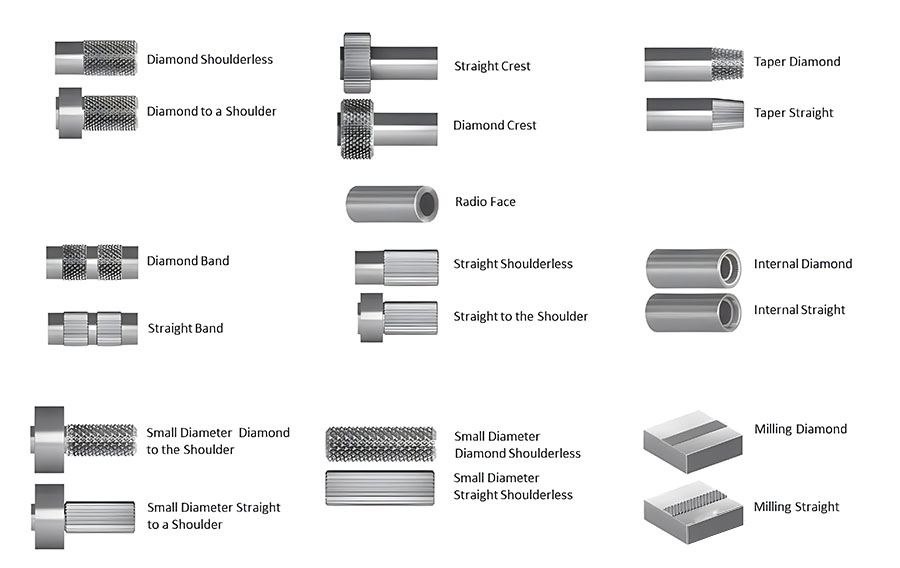Knurling is a manufacturing process used in CNC machining to create a pattern of raised ridges on a surface, providing improved grip, aesthetics, or a combination of both. This technique is commonly employed in various industries for applications ranging from tool handles to decorative elements. Let’s explore the significance of knurling in CNC machined parts.
What is Knurling?
Knurling is a specialized manufacturing process employed to create a textured pattern of raised ridges on the surface of a cylindrical workpiece. This technique is widely utilized in various industries to enhance the functionality, grip, and aesthetic appeal of components.
Purpose of Knurling:
Improved Grip: Knurling is often applied to provide a tactile surface for improved grip. This is particularly crucial in applications where manual manipulation of objects is involved, such as tool handles, knobs, and control surfaces.
Decorative Elements: Beyond functionality, knurling is used for decorative purposes. It adds a textured or patterned surface, enhancing the visual appeal of the part.
Types of Knurling Patterns:
Straight knurling
Straight or linear knurling forms linear and parallel grooves along the axis of cylindrical parts. This can be used for gripping or decorative purposes. It is also widely used to facilitate push in assembly of permanently joined parts. This allows for lower part accuracy with very good concentricity and very tight fit, which will perform the same service as other methods, such as higher force smooth push fit or low-temperature push fit, but with lower operating costs.
Diamond knurling
This mode uses two straight cut mode wheels that roll at a certain angle with the axis of the cylindrical part. It jointly imprints overlapping inclined grooves, forming diamond pattern cross hatching. The angle between grooves is usually fixed at 30 °, but there can also be a certain range of angles.

Knurling Tools:
Product engineers use different knurling tools based on expected applications and desired results. It is recommended to consider the properties of the selected material, such as ductility and hardness, in order to achieve a good rolling effect. Here are some key tools for metal embossing.
1. Steering wheel
Knurling wheel is the most commonly used tool for metal knurling. They typically include two or more hardened steel wheels with relatively inclined knurled patterns. These wheels are usually connected to a knurling tool and pressed against a rotating workpiece to produce a preferred knurling pattern.
2. Knurled inserts
These are specialized tools that can be fixed on a lathe for mechanical processing. The embossed insert has a specific embossed pattern that can be programmed to produce the preferred embossed surface. Blades usually have different patterns and sizes, and are made of hard alloy or high-speed steel.
3. Knurling mold
These molds are tools used for turret lathes or CNC turning services to achieve embossed patterns on cylindrical objects. The embossing mold is made of high-speed steel, and its embossing pattern cuts into the inner surface of the object. You must install them on the knurled tool holder and rotate them relative to the workpiece to create the desired knurled pattern.
4. Push type knurling tool
Push type knurling tool is a handheld knurling tool that uses manual force to create a knurling pattern. Push type tools typically consist of a knurled wheel connected to the handle, which helps them move along the surface of the workpiece to form the desired knurled texture. They are compatible with low volume or manual operation.
5. Floating knurling tool
This embossing tool is suitable for creating patterns and ridges on surfaces with contours or irregularities. These tools can adapt to the shape of the workpiece, ensuring consistency and accuracy in the embossing process. Floating tools use articulated arms or spring loading mechanisms to align the knurled wheel with the surface contour.
Applications of Knurling:
Tool Handles:
Knurled patterns on tool handles enhance grip, making it easier for users to handle tools securely.
Control Knobs:
Devices with control knobs, such as those on audio equipment or machinery, often feature knurled surfaces for ease of adjustment.
Decorative Elements:
Knurling is also employed for decorative purposes on various products, adding a tactile and visually appealing texture.
Considerations in Knurling:
Choose the Appropriate Knurling Tool
Choosing the knurling tools that fit the desired patterns and material is crucial. Knurling tooling comprises varying tooth configurations, pitches, and patterns. Therefore, using the ideal tool for the material’s hardness and the intended surface finish is advisable.
Apply Lubrication
Ensure that the knurling tooling and workpiece receive appropriate cutting fluid or lubricant during the operation. It reduces heat generation, friction, and tool wear, producing a smooth, knurled finish.
Optimal Cutting Speed
Knurling metal at the right speed reduces tool wear while ensuring proper chip formation. Therefore, it is advisable to determine the ideal lathe cutting tool and cutting speed based on the knurled metal. Refer to the manufacturer’s directions or the machining recommendations for a specific material.
In summary, knurling is a versatile manufacturing technique used for both practical and decorative purposes. Whether for enhancing grip on tools or adding a unique texture to a product, knurling plays a significant role in various industries.



